 Keep the tree trunk as a single stem. Don’t allow groups of heavy branches to grow from the lower part of the tree.
Keep the tree trunk as a single stem. Don’t allow groups of heavy branches to grow from the lower part of the tree.Want your flowering trees and shrubs to look their best each year? That’s every gardener’s goal. In this chapter, you’ll learn about pruning your favorites, including lilac, forsythia, viburnum, and hydrangea. For information on rhododendrons and other evergreen bloomers, check the section on broadleaf evergreens in chapter 7.
Q How can I train my Japanese tree lilac to stay strong and healthy and look its best?
A Some plants, such as Japanese tree lilac (Syringa reticulata) and mountain ash (Sorbus spp.), form a lot of lower limbs. Remove these for a more treelike effect, especially until the specimen is mature. As a rule, the branches on most ornamental flowering trees are not heavy, and their berries and fruit seldom add much weight, so careful training of the limb structure is not as necessary as it is on fruit trees.
A properly pruned flowering tree will be strong and less likely to break in wind- and ice storms. Flowering crab apples can live for over a century and tree lilacs for even longer. The key is to train the tree to grow with a central leader for the first 10 feet at least. In other words, train a flowering tree as a tree rather than as a large bush.
Q What should I keep in mind when I prune my flowering trees?
A Follow these guidelines to keep flowering trees attractive and healthy:
 Keep the tree trunk as a single stem. Don’t allow groups of heavy branches to grow from the lower part of the tree.
Keep the tree trunk as a single stem. Don’t allow groups of heavy branches to grow from the lower part of the tree.
 Remove all suckers that sprout from the roots. Grafted trees such as flowering crab apples and hawthorns may send up a lot of suckers from the rootstock. Cut them off immediately, because they grow so fast that they can quickly overtake and crowd out the desirable part of the tree.
Remove all suckers that sprout from the roots. Grafted trees such as flowering crab apples and hawthorns may send up a lot of suckers from the rootstock. Cut them off immediately, because they grow so fast that they can quickly overtake and crowd out the desirable part of the tree.
 Prune back branches that upset the symmetry and appearance of the tree.
Prune back branches that upset the symmetry and appearance of the tree.
 Remove all branches growing close to the ground. They interfere with lawn mowing and are unattractive.
Remove all branches growing close to the ground. They interfere with lawn mowing and are unattractive.
 Thin. As the tree gets older, take out branches growing too densely or crossing others, so the remaining ones continue to bloom well. Remember, thinning enables air to move and light to penetrate the crown. Avoid overpruning.
Thin. As the tree gets older, take out branches growing too densely or crossing others, so the remaining ones continue to bloom well. Remember, thinning enables air to move and light to penetrate the crown. Avoid overpruning.
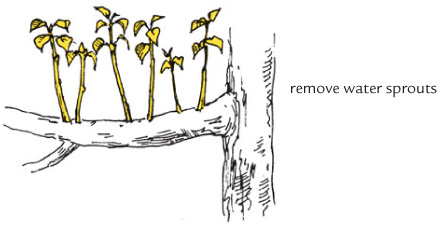
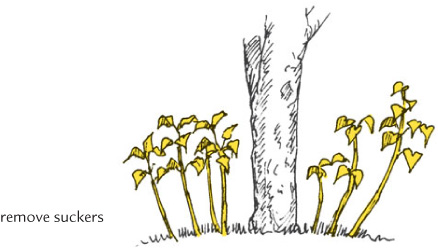
Q It’s not spring until my flowering crab apple comes into bloom. I know it needs some tidying up. How can I do that without changing its natural form?
A Follow these steps, consulting the drawing below:
1. Cut off all suckers.
2. Prune branches that upset the tree’s symmetry.
3. Remove low-growing branches.
4. Thin out crossed and densely growing branches.
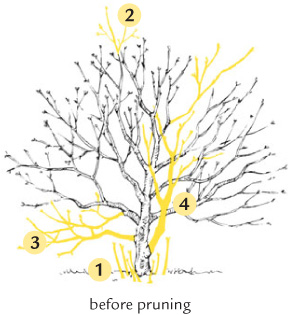
The result is a graceful, airy tree, which is not only attractive, but also healthy.
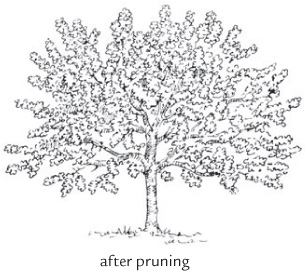
Q What’s the best time to prune my flowering cherries?
A For maximum bloom, prune them just after the blossoms fade. Prune trees that produce attractive berries or fruit in late winter so you won’t interfere with the display.
Q Is it worth my time to restore an old flowering tree that used to be pretty but now looks kind of sad?
A The answer depends on the variety of plant, its vigor, the care with which you prune, and your climate. You can slash back some tropical and semitropical plants mercilessly and they will quickly grow back into youthful, handsome plants. Trees and shrubs in northern climates need to be treated more carefully, and in most cases it’s best to spread out major pruning jobs over several years.
Cut back only a few limbs at a time, and as they regrow, you can remove a few more. In this way, you can revitalize your tree. Gradual renewal is better for the plant’s health, and its appearance is less drastically altered in the process. Late winter or early spring is usually the best time for such restorative pruning. The plant will be entering its period of most vigorous growth and thus be more resilient.
Keep in mind that flowering shrubs and trees have definite life spans, and if they are nearing the end of their days, pruning won’t help them revive. Just as with fruit and shade trees that reach this stage, it is better to cut them down and plant new ones nearby.
Q Do I need to prune my flowering shrubs?
A Many shrubs rarely need pruning, except to remove dead or damaged branches. Sometimes, however, you must remove old wood to rejuvenate them, thin wood growing too thickly, and keep suckers under control. Some shrubs, such as bush honeysuckle, viburnum, and lilac, may grow too tall for their location and need heading back. A few, including many forsythias, produce dense thickets of branches; annual thinning can reduce the number of dead or straggly twigs in spring.
Q I’m confused. When do I prune my flowering shrubs?
A Prune shrubs that form flowers on new wood (grown the same season) in late fall, late winter, or early spring before the buds show green and not when they are actively growing. The best time to prune a flowering shrub that blooms on old wood (at least one year old) is just after the blossoms have faded, before it grows new branches and forms the buds that will bloom the next year.
Late winter is the best time to prune the shrubs that are grown mostly for their foliage (Japanese maple) or those grown primarily for the beauty of their winter bark (redtwig dog-wood). Remove broken, dead, rubbing, or diseased branches whenever you notice them.
SEE ALSO: Plant-by-Plant Pruning Guide, starting on page 311.
Some shrubs to prune when dormant (before bloom)
Beautyberry (Callicarpa spp.)
Bluebeard (Caryopteris × clandonensis)
Bottlebrush buckeye (Aesculus parviflora)
Bush clover (Lespedeza thunbergii)
Butterfly bush (Buddleia davidii)
Crape myrtle (Lagerstroemia indica)
Red chokeberry (Aronia arbutifolia)
Rose of Sharon (Hibiscus syriacus)
Southern bush honeysuckle (Diervilla sessilifolia)
Summersweet (Clethra spp.)
Some shrubs to prune after bloom
Azalea (Rhododendron spp.)
Beauty bush (Kolkwitzia amabilis)
Broom (Cytisus spp.)
Deutzia (Deutzia spp.)
Forsythia (Forsythia spp.)
Fothergilla (Fothergilla spp.)
Mock orange (Philadelphus coronarius)
Rhododendron (Rhododendron spp.)
Viburnum (Viburnum spp.)
Virginia sweetspire (Itea virginica)
Weigela (Weigela spp.)
Witch hazel (Hamamelis spp.)
Q My summersweets are starting to look big and messy. How do I get them back in shape?
A Summersweet (Clethra alnifolia) blooms on new wood. It can spread by suckers and look unbalanced over time. If you prune it lightly in late winter or early spring, you can avoid drastic pruning later on. Just remove excess suckers, damaged branches, and some of the oldest, longest shoots by cutting them off at the base; that promotes new growth from the ground without sacrificing any flowers.
If you grow shrubs that bloom on old wood, such as glossy abelia, Japanese kerria, and viburnums, you can use the same method to keep them groomed, waiting until right after blooming to prune them in order to preserve the current season’s blooms.
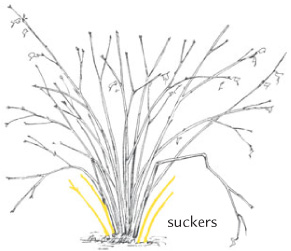
Check the plant-by-plant guide (page 311) to determine whether your shrub blooms on old or new wood. Then follow these steps when pruning:
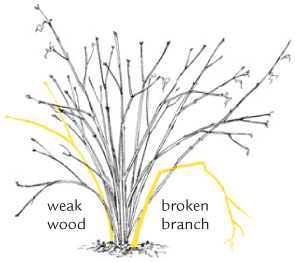
1. Remove all suckers.
2. Remove dead, broken, and weak wood.
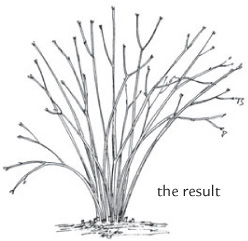
3. Remove some older, taller branches.
4. The result — a neater, healthier shrub.
Q I love lilacs. When should I prune them? Do they bloom on old or new wood?
A Lilac (Syringa spp.) is one of the most widely planted and beloved flowering shrubs in the country. Lilacs were introduced into the colonies so long ago that some bushes growing in American yards are more than 200 years old. Enjoy the sweet scent of lilacs, which bloom on old wood, and delay pruning until right after they bloom.
After the shrub blooms, cut off the spent flowers (deadhead). Remove fading blooms only; don’t touch the stems and leaves. Clip just above the buds forming for next year’s blooms. The farther you cut back, the more likely that you are picking off next year’s blooms. By pruning off the old blossoms, you help to ensure regular blooming. Of course, if you have a long hedge of tall-growing bushes, this snipping may be impractical and you’ll have to settle for heavy blooms whenever the lilacs want to provide them.
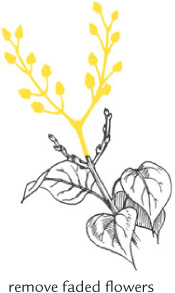
Q We just bought an old farm with several ancient, straggly, but super-fragrant lilacs growing by the house. How should I prune them?
A Because lilacs are such long-lived plants, often they are long overdue for attention. Neglected, elderly bushes need careful pruning with both clippers and a saw.
Follow these steps when renewing lilacs and other old shrubs in early spring:
1. Select several of the strong, younger trunks to remain. These will become your new bush. Cut off all the rest (those shaded in drawing), especially old and decrepit ones — these have lost most of their vitality anyway. Make all cuts close to the ground, and cut carefully so that you don’t slash into any adjoining stems. The exact number of trunks you leave will depend on the area your bush covers and whether you want to shrink its size.
2. Cut away the small, thick sucker growth at the plant’s base. These stems crowd both the main bush and each other. Removing them will let you see which of the larger stems (shaded in drawing) still need to be cut.
3. After pruning, help the bush recover and thrive by feeding it dried or composted manure (about 20 pounds for the average-sized bush). Scatter this in a circle a foot away from the bush and let a light spring rain wash it into the soil.
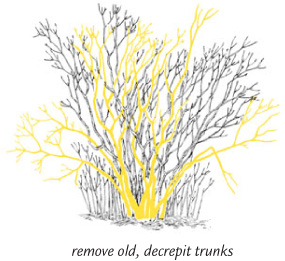
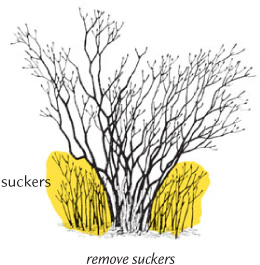
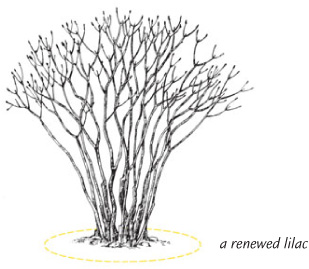
Q Will I hurt a flowering shrub by cutting off some blooms for a bouquet?
A No. Picking beautiful flowering stems is one of the great pleasures of growing a flowering shrub. You won’t harm the plant if you cut properly, and you’ll accomplish some of your pruning. Just pay attention to where and how much you cut. Here’s how to thin stems for a bouquet:
 Whenever possible, choose blossoms growing toward the interior of the plant. This way, taking a bouquet will not be as noticeable, plus you’ll be helping the plant to maintain a pleasing shape.
Whenever possible, choose blossoms growing toward the interior of the plant. This way, taking a bouquet will not be as noticeable, plus you’ll be helping the plant to maintain a pleasing shape.
 Cut the stems to another branch without leaving a dead stub.
Cut the stems to another branch without leaving a dead stub.
 Never tear off stems or you’ll damage the plant.
Never tear off stems or you’ll damage the plant.
 Although heavy picking isn’t likely to disturb an older, well-established plant, cut sparingly, if at all, from young bushes.
Although heavy picking isn’t likely to disturb an older, well-established plant, cut sparingly, if at all, from young bushes.

Q Peegee hydrangeas are my favorite shrubs, but I’m scared to prune them for fear of destroying the flowers. When can I cut them back?
A Pruning hydrangeas is unnecessary unless you want to manipulate the size and amount of flowers, control the size of the shrub, or clean out old or dead wood. The best time to prune the white- to pink-flowered Hydrangea paniculata cultivars such as ‘Grandiflora’ (peegee), ‘Tardiva’, ‘Unique’, and ‘Limelight’, is during dormancy, since they bloom on new wood (see summersweet question on page 98). For bigger blooms on a smaller shrub, you can prune panicle hydrangeas hard by cutting back stems to two pairs of buds early in late winter or early spring. Smooth hydrangea (H. arborescens) cultivars such as ‘Annabelle’ and pink INVINCIBELLE SPIRIT also bloom on new wood and can be pruned by cutting them back hard when they are dormant.
Q How do I prune other hydrangeas?
A Bigleaf hydrangea (Hydrangea macrophylla) blooms on the previous year’s growth. Traditionally, you prune it after the flowers fade, from late spring to August. Doing so preserves this season’s flower buds, which are mostly at the stem tips. An alternative is tip pruning in early spring to get rid of winterkill and force lateral (side) flower buds to grow for more abundant blooms.
Oakleaf hydrangea (H. quercifolia) needs little trimming except for taking out dead and weak stems at the base either in early spring or after flowering. Climbing hydrangea (H. petiolaris) flowers on old wood but rarely needs pruning. Cut back unwanted lateral shoots after flowering in early to midsummer.
Q I have the perfect spot for a hydrangea tree, but I can’t afford the ones at the nursery. How can I turn a shrub hydrangea into a tree?
A Some shrubs make pleasing single- or multi-trunk trees. To start, you need just pruners and a little patience. Peegee hydrangea (H. paniculata ‘Grandiflora’, pictured here) grows quickly and eagerly and responds well to training.
Follow these simple steps to turn a multi-trunk hydrangea into a single-trunk tree:
1. The first year, prune to a single stem.
2. The second year, cut off lower branches.
3. Continue to prune off bottom branches as the tree grows taller until the desired treelike form is reached.
4. The finished product — a handsome plant, in and out of bloom.
Other shrublike trees that can be pruned to a single trunk include: Blackhaw (Viburnum prunifolium), buttonbush (Cephalanthus occidentalis), chaste tree (Vitex agnus-castus), Hally Jolivette cherry (Prunus ‘Hally Jolivette’), Japanese angelica (Aralia elata), nannyberry viburnum (Viburnum lentago), oleander (Nerium oleander), possumhaw, smooth witherod (Viburnum nudum), rose of Sharon (Hibiscus syriacus), sargent crab apple (Malus sargentii), serviceberry (Amelanchier spp.), Siberian pea shrub (Caragana arborescens), siebold viburnum (Viburnum sieboldii), silk-tassel (Garrya elliptica), wayfaring tree (Viburnum lantana).
Q How do I prune ornamental berry shrubs for a great display
A Most berry-producing shrubs, such as cotoneaster, fire-thorn, and viburnum, need little pruning. If the fruit is important, prune lightly to keep them in shape and to correct damage caused by animals, weather, disease, or insects.
Note that some berry-producing shrubs, including bay-berry and winterberry, are dioecious, meaning that plants are either male or female. For fruit production, you need both male and female plants. If you want berries, you have to plant a male among several female plants.
Q My wife likes to cut branches of holly, cotoneaster, viburnum, and other berry shrubs to decorate the house. Is this bad for the plants?
A When a plant is small, it isn’t a good idea to cut off the branches, although a few berries can be snitched with no harm. As a bush gets older, however, you can gather a moderate amount of the colorful berries to use for bouquets or holiday decorations. Naturally, it is better to cut off branches with clippers rather than to break them off in jagged tears. Since most of next year’s fruit buds are near the ends of the limbs, don’t sacrifice too many of them.
Q When’s a good time to prune ornamental fruit- and berry-producing shrubs?
A Prune them when dormant, either in early spring before growth begins or in winter after the berries have either passed their prime or been eaten by birds.
FRUIT- AND BERRY-PRODUCING SHRUBS
Prune these fruit and berry shrubs when dormant:
Bayberry (Myrica pensylvanica)
Beach rose (Rosa rugosa)
Chokeberry (Aronia spp.)
Cotoneaster (Cotoneaster spp.)
Firethorn (Pyracantha coccinea)
Hawthorn (Crataegus, best with a minimum of pruning)
Heavenly bamboo (Nandina domestica)
Pomegranate (Punica granatum)
Winterberry (Ilex verticillata)
Q The first few years I had my redtwig dogwood, its bright red winter color was great. Now the bark looks dark and dull. What’s wrong?
A Most likely your shrub just needs pruning, because the best color appears on the new growth. To keep the stems fresh and new, some people cut back their shrubby dogwoods to 12 inches when dormant, removing that season’s spring blooms. If you like the flowers, cut back the shrub every other year instead of annually. Pruning will also keep its suckering habit in check. If you prefer a more conservative approach, cut down one-third of the oldest stems every year.
SHRUBS WITH COLORFUL BARK
Careful pruning displays the bark of these shrubs to advantage; sometimes it even brightens the hues of the bark.
Bloodtwig dogwood (Cornus sanguinea)
Coral bark willow (Salix alba ‘Chermesina’)
Golden or yellowtwig dogwood (Cornus sericea ‘Flaviramea’ and ‘Budd’s Yellow’)
Golden willow (Salix alba ‘Vitellina’)
Japanese clethra (Clethra berbinervis)
Japanese kerria (Kerria japonica)
Red osier dogwood (Cornus sericea)
Tartarian or redtwig dogwood (Cornus alba)
Winter jasmine (Jasminum nudiflorum)
Q Do all roses need pruning, including those advertised as easy to grow?
A Probably. We all want our rosebushes to live up to their full, beautiful potential. If you were to ask anyone, young or old, to name the perfect flower, it would likely be the rose. For centuries, in both legends and backyard gardens, the rose has been one of the world’s most popular flowers. Contemporary breeders have developed disease-resistant roses in a wide range of shapes and colors. There are roses that bloom on bushes, vines, hedges, and even trees. Rose petals and hips are popular in teas, jellies, potpourris, and numerous other culinary and aromatic concoctions. It’s only right that the rose gets special mention when it comes to pruning.
Most roses benefit from pruning. The goal of rose pruning is to promote plant health by opening the center of the plant to sun, light, and circulating air.
Q I’ve ordered some mail-order bare-root roses for my garden. Do they need pruning before planting?
A Depends. Roses are sold bare-root and potted. Don’t prune back a potted rose; it’s already established and growing. A bare-root one, on the other hand, may need a little attention, and because it is still dormant, you can cut safely. Here’s what to do:
1. Once you get your bare-root rose home, soak it in a bucket of water for a few hours or overnight to hydrate it.
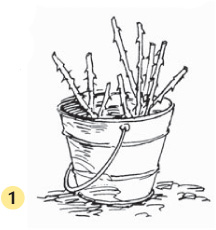
2. Check the root system, and trim off any damaged or dead growth.
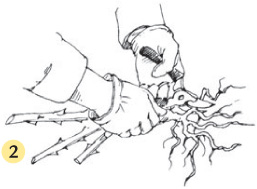
3. If the plant is more than 8 inches high and has never been cut back or has been only partially cut back, cut down your rose to about 6 or 8 inches above the dark line that shows where ground level was when it was dug. Be sure to cut to a live bud or branch each time so that you leave no dead stubs.
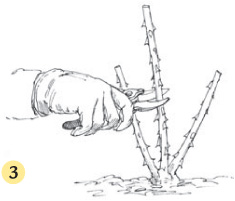
Q Where do I make a pruning cut on a rose cane?
A Always cut on a slant just above a bud or to a live branch, and retain enough leaves and stems to feed the plant. For cutting heavy branches, you may need a saw or loppers.
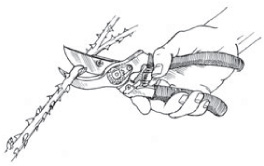
GENERAL ROSE MAINTENANCE
Most roses are thorny critters, and you’ll appreciate a pair of heavy gloves when you’re pruning and carrying away the clippings. Be especially careful to use sharp bypass clippers so that you don’t crush the stems and cause cell damage.
The kind of pruning you do, and when you do it, varies according to the classification of your rose and your climatic conditions. Hybrid tea roses need the most pruning, whereas species roses usually require very little. Although some polyantha, floribunda, and hybrid tea roses are quite vigorous, others have been weakened by hybridization and need special care, especially for the first year.
 Hold off cutting any blooms with long stems from hybrid teas during the first year. In future years, once a plant has several strong, tall canes, moderate cutting of blooms will be fine.
Hold off cutting any blooms with long stems from hybrid teas during the first year. In future years, once a plant has several strong, tall canes, moderate cutting of blooms will be fine.
 Cutting roses in full bloom, with long stems and some leaves, is actually summer pruning, so be sure that you don’t scalp the plant.
Cutting roses in full bloom, with long stems and some leaves, is actually summer pruning, so be sure that you don’t scalp the plant.
 To grow a large exhibition flower, practice disbudding: pick off all the smaller buds along the stem and leave only the large, fat bud at the top.
To grow a large exhibition flower, practice disbudding: pick off all the smaller buds along the stem and leave only the large, fat bud at the top.
 Unless you’re growing a rugosa or other rose with showy hips, always snip off fading blooms, to direct the plant’s energy into making buds for next year’s display.
Unless you’re growing a rugosa or other rose with showy hips, always snip off fading blooms, to direct the plant’s energy into making buds for next year’s display.
 Always cart away clippings from the rose garden; they can become a breeding place for diseases and insects if left on the ground.
Always cart away clippings from the rose garden; they can become a breeding place for diseases and insects if left on the ground.
 You can prune heavily those roses that grow vigorously, but cut wood sparingly from the slower-growing, weaker kinds. Heavy pruning doesn’t always stimulate a weak plant to grow faster. In fact, depriving it of necessary leaf area may make it lose vigor and produce fewer blooms.
You can prune heavily those roses that grow vigorously, but cut wood sparingly from the slower-growing, weaker kinds. Heavy pruning doesn’t always stimulate a weak plant to grow faster. In fact, depriving it of necessary leaf area may make it lose vigor and produce fewer blooms.
Q When should I prune my rosebushes?
A That depends upon where you live and what you want to remove. Most live-wood rose pruning occurs in early spring, just as the buds are beginning to swell. Hard frosts are usually over by this time, and the sap isn’t yet flowing enough to cause a heavy loss from the cut ends. In very mild-winter climates, however, late winter is best for rose pruning. Rose gardeners traditionally prune ramblers right after they flower.
Q I’d like to try growing hybrid tea roses, but I’ve heard that pruning them is complicated. Should I give it a try?
A You bet! The glamorous blossoms produced on your hybrid tea will make your efforts worthwhile. Hybrid teas are the most common roses in the United States. Hundreds of named varieties are offered in catalogs, garden centers, and supermarkets every spring. You can choose from recently introduced, patented varieties or the old reliable favorites such as ‘Peace’ and ‘Mister Lincoln’. You must prune them each year to keep them blooming well. The flowers bloom on new shoots sprouting from canes that grew the previous year.
Q What’s the best way to prune hybrid teas?
A Follow these steps:
1. Thin out old, weak, and winter-damaged canes and those that cross, rub, or grow too close together. If you prefer tall-growing roses, you may not want to shorten them much except to make drooping canes a bit stiffer. If short, bushy plants fit better into your garden scene, cut the ends of the canes farther back to bud eyes where you can see some new growth. For bigger but fewer flowers, cut back stems to 6 inches high.
2. Remove suckers originating from below the graft. Take them off as close as possible to the roots or stem where they emerge. They detract from the bush’s appearance and won’t resemble the plant above the graft. Pruning should result in a bowl-like plant with the center open to light and air.
3. Cut back older main stems to strong new shoots.
4. Cut back to five or so strong canes, each about 10 to 18 inches above the bud union. When spring arrives, the plant will burst into vigorous new growth, and it will regain its former height come summer. If cane-boring insects are a problem for you, you can seal cuts on healthy pith with wax or white glue.

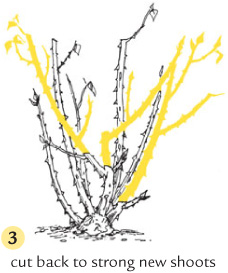
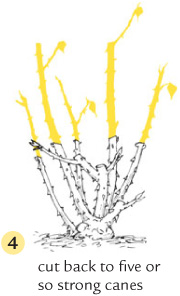
Q My hybrid teas produce medium-sized flowers. Can I get my bushes to grow big blooms like those at the florist?
A To help your hybrid tea roses reach their full potential, pinch off side buds when they’re still small, leaving only the terminal bud on a stem. (This is called disbudding.) Although you won’t get nearly as many flowers as you would without pinching, each bloom will be big and gorgeous. For floribunda and grandiflora roses, remove the terminal bud, which blooms first, so the other buds in the spray will open together without having a hole in the center of the cluster. Or experiment and see what happens when you prune to a single flower.
Intervene anytime you see swelling flower buds; timing varies depending on the plant. The sooner you disbud, the faster the plant’s strength will become concentrated on the remaining buds — with magnificent results.
Disbudding can also be done later, when flowers are about to go into a bouquet. Florists commonly disbud plants because sometimes one large blossom is more desirable than a lot of smaller ones in an arrangement. Professional plant exhibitors may disbud for show-quality specimens. While this technique is fun to try, especially if you like to pick flowers for bouquets, too many king-size blooms in a garden look unnatural.
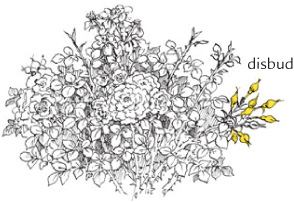
Q I live in Illinois, where winters are cold. Can I grow hybrid teas, and if so, will they need special pruning?
A If you live in a cold-winter area (USDA Zone 6 and north), take steps in the fall to protect your plants. In late fall during early dormancy, prune back tall canes to about 36 inches, thus stabilizing the rose and preventing it from heaving in the wind. Cover with 12 inches of compost or topsoil, mounding over the entire base. Do this before the temperature drops below 15°F. Don’t worry if all the leaves haven’t fallen off. In early spring, you may still find some winter injury despite the covering. Prune any affected canes to live white pith.
Q Do I prune other roses the same way as hybrid teas?
A Each rose classification has slightly different pruning needs.
Floribundas resemble hybrid teas; however, they have several flowers in sprays rather than one to a stem, and they are generally shorter-growing. Prune them like hybrid teas. For bigger but fewer clusters, cut back stems to about 6 inches high.
Polyanthas produce clusters of small and medium-sized blooms, which are seldom disbudded. The bush needs minimal pruning; just trim to the size you choose. Remove nonflowering wood. If your polyantha shows signs of spider mites, take leaves off the bottom few inches to prevent them from getting a grip on your plant.
Q I want to plant a hedge of rosebushes. How should I prune it?
A Hedge roses need heavier pruning at planting time than do those grown as specimens in the garden. Set the plants 2 feet apart or slightly closer, and prune them to within 4 or 5 inches of the ground when you plant them. Each spring, cut back enough to produce a bushy, hedgelike effect. In summer, when bushes grow too tall or wide, snip the ends to keep the hedge looking even.
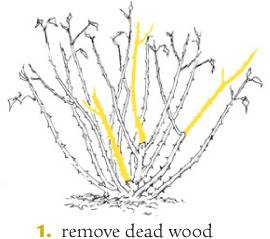

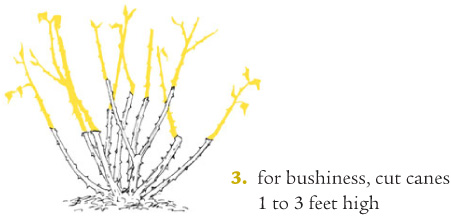
Some shrub roses, especially rugosas, produce large numbers of red seedpods called hips. These are a rich source of vitamin C. Although it is better to cut off fading blooms of most roses so that bushes won’t produce energy-draining hips, rugosas are so vigorous that it doesn’t harm them a bit to let the hips develop. Pick off hips after a light frost, before they freeze hard and turn mushy. Among other roses with showy hips are musk rose (R. moschata) and sweetbriar (R. eglanteria).
Q How do I prune old roses, species roses, and shrub roses?
A Pruning methods for each are similar, depending upon their use in the garden and their relative vigor.
Modern shrub roses resemble old-fashioned roses and have a half-wild appearance. They can grow for years with no care at all but look their best with some attention. They are usually allowed to grow tall for a hedge effect, but if you like shorter, heavier-blooming plants, you can cut back the bush to 1 foot from the ground early each spring, before growth starts. Prune English roses — shrub roses combining aspects of old garden roses and modern roses — lightly or hard depending upon the vigor and desired size of the plant. The most robust varieties gain from summer pruning, cutting back flowering stems to two or three buds after each flush of bloom.
Species and old roses include moss roses, sweetbriars, cabbage roses, and rugosa roses, and they are pruned in nearly the same way. All are vigorous, so if you don’t prune them annually, cutting back heavily every few years may be necessary. At a minimum, remove dead wood, some old canes, and stray long shoots every couple of years.
Q Is there a difference between climbing and rambling roses?
A Climbers differ from rambling roses in having a more upward habit of growth that better enables them to climb a trellis or pole. Many of the best hybrid tea roses are now available in climbing form. Their flowers are large, and they bloom for most of the summer, unlike the short blooming season of the ramblers.
Ramblers bloom once a year and are not grafted. All the new canes coming from the roots are part of the main plant, so you don’t need to worry about wild suckers crowding out good canes. Let ramblers ramble. If the plant grows too thickly, cut out the oldest canes. If the plant gets too big, prune it as you would a climber. Choose ramblers carefully for size, since they are so vigorous that they can quickly outgrow their planting space and may need heavy pruning that reduces the next season’s bloom.
Q How do I prune climbing and rambling roses?
A Just follow these simple steps:
1. For repeat-blooming climbers, remove dead and unproductive canes at the ground and cut back canes that have bloomed recently to about 6 inches. If the remaining new, strong canes still seem to be too numerous, cut out a few of these also. Aim for five strong, husky canes to remain.
2. Prune off the top few inches of any nonbranching canes. Also, snip off weak growth on the new canes.
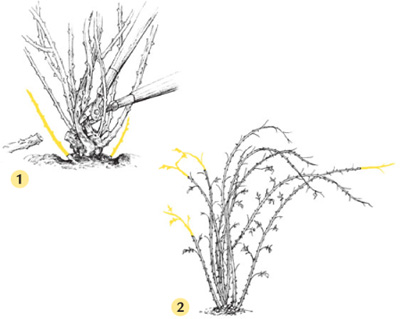
3. Prune back branches that have flowered by one-third, ending above a healthy bud or shoot.
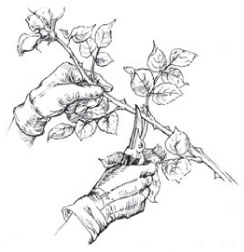
Q What’s a good way to train a climbing rose to grow on a trellis against our house?
A Climbers look better if you allow a few tall, narrow branches to reach the top of a trellis, where they can grow thickly and then cascade downward while blooming heavily. To encourage this kind of growth, remove most of the weak canes so that the plant’s strength goes into the few that remain. Cut them in early spring, when the plant is dormant. Clip off fading flowers to encourage repeat blooming.

The following steps will show you how:
1. Climbing roses need good ventilation when grown against a wall. Keep the trellis at least 3 inches from the wall.
2. As they grow, tie the stems to the trellis with strips of cloth. Avoid unnecessary pruning until the rose covers the trellis.
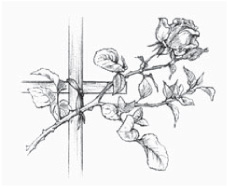
3. Steer some of the new canes to grow outward to cover the trellis early. By training some of the canes horizontally, you’ll increase bud set and flowering.
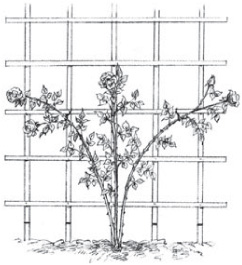
4. Continue to snip off branches that are growing too thick. Every three years, cut out a few of the older canes and allow others to replace them.
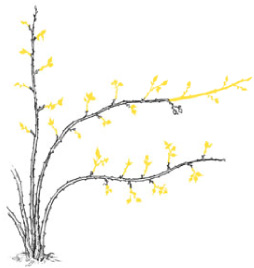
Q How do I keep my rose tree looking good?
A Tree roses, or rose standards, are usually hybrid tea, grandiflora, or floribunda roses that have been grafted or budded on top of a briar or rugosa rose rootstock that is 3 feet high or more. Keep rose standards healthy and attractive by removing suckers growing on the main stem or from the roots as soon as they appear, or they will crowd out the grafted rose in a short time. Follow these steps:
1. Thin out weak and/or old branches that are no longer blooming well.
2. Remove crossing branches.
3. Cut back remaining branches to 5 to 10 inches from the graft.
